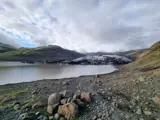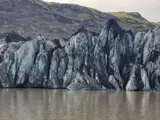Sólheimasandur & Sólheimaheiði
Sólheimajökull
flow from higher areas.
The glacier has undergone large scale changes over the last 100 year. The location of the glacier snout has been measured annually since 1930 and those measurements, along with aerial photos, have made it possible to map out its history. Between 1930 and 1969 the glacier retreated about 977 m, but after 1969 the climate got colder and the glacier advanced until 1995. During that time, the glacier advanced about 495 m and its thickness increased about 100 m. After 1995 the glacier started to retreat again and in 2010 it was about 1 km further back in the valley than it had been in 1930 and about 120-150 m thinner than it was in 1960. Since 2010 the glacier has continued to retreat and could disappear completely within the next 100-200 years. A lagoon started to form in front of the glacier snout in 2011 and has grown in both size and depth since then. The lagoon is 60 m deep and will continue to grow while the glacier is retreating and could become up to 4 km long in the next few decades if the glacier keeps retreating.
Outlet glaciers:
Glaciers in Iceland are normally temperate glaciers, meaning that the temperature of the ice is at freezing point and liquid water is therefore found both under and within the ice. That facilitates deformation and the flow of the ice, but glaciers move forward due to their own weight and incline in the landscape. The rate of movement depends on how much water is underneath the glacier, the temperature of the ice and the incline of the landscape. Glaciers move more quickly during the summertime than the wintertime as more water is normally underneath the glaciers then. Glacier crevasses are commonly found on outlet glaciers and are formed when the glaciers move over uneven grounds or moves along a mountain side. The crevasses are formed in the top 20-30 meters of the glacier, as the ice there is brittle, but further down the ice is less brittle and does not break. High quantity of rock fragments can be underneath, within and on top of outlet glaciers and is called till. The till forms due to both rock collapses that land on top of the glaciers and due to scraping of the bedrock below the glaciers themselves, but ash can also collect on top of them. The glaciers carry the material with them, often forming thick and black layers near the glacial snout, before depositing it in moraines in front of the glaciers. The material can affect the melting of the glaciers as, if the material is thinner than 1-2 cm it accelerates the melt but if it is thicker it slows down the melt. There are many important glacial sediments and formations near Sólheimajökull outlet glacier, and the area has been used to study the glacial- and environmental history of Iceland. It is therefore important that we treat the area with respect and preserve the formations. A hiking trail leads from the car park to Sólheimajökull outlet glacier, and people should not wander off the trail. There are also a few hiking paths in the area which can be accessed by using the Wapp.
Celebrating Earth Heritage
How to visit the Katla Geopark
Katla UNESCO Global Geopark is in central South Iceland

